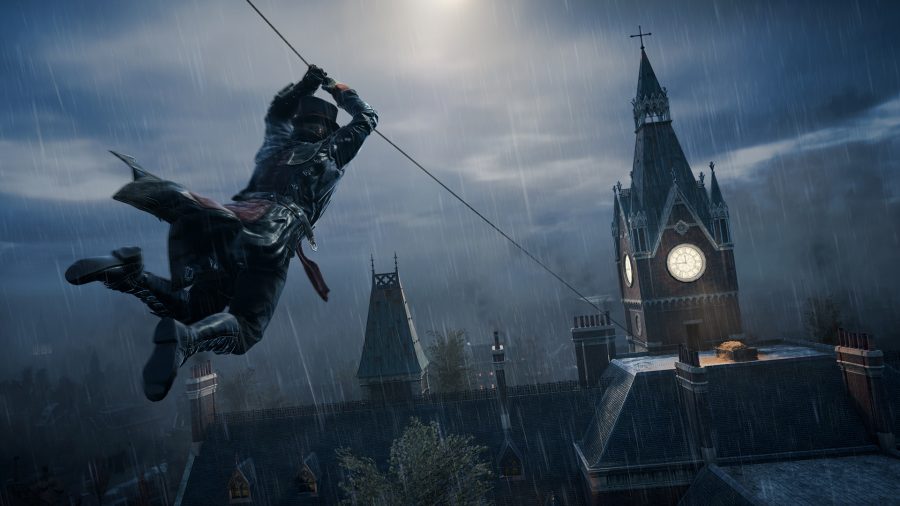Children shovel coal, their faces smudged in dark dust, in a large industrial factory as their jailer angrily stands near them pacing back and forth. Members of the notorious London gang, the Blighters, dressed in red and wearing bowler hats, patrol the three levels of the factory. They chat among themselves about their employer, Crawford Starrick, as a grey hooded assassin sneaks in from the skyline.
Walking along a roofing beam, the assassin scans the room, highlighting the enemies in red as she crouches above one of the Blighters. He’s a heavy set fellow, bald, with a crooked nose that suggests he’s been in more than one fight in his life. Popping a hidden blade from her wrist, the assassin lands on the man’s back, knocking him to the ground with a soft thud, and silently takes him out.
“Assassin’s Creed: Syndicate,” the new installment in the popular “Assassin’s Creed” franchise, takes players to the industrialized era of Victorian England. Cast in a dual role as twin assassins, Evie and Jacob Frye, players must take back control of the city from the oppressive rule of Templar, Crawford Starrick, and prevent him from finding an ancient artifact that could grant him unlimited power.
“Syndicate” builds on the framework of the past entries in the series, offering the most polished and intricate Assassin’s Creed game in some time. Gone are the stuttering frame rates and bugs that plagued the last entry. Traversing across roof tops and battling against enemies has never felt smoother. This is helped by a revamped combat system that allows players to fight multiple enemies at once and deliver devastating combos.
Likewise, the rope launcher and the introduction of carriages makes traversing across London a breeze. At times, I felt like a Victorian Batman, singing the 1960s themes song as I swung up the side of Big Ben. Carriages add a chaotic element to the franchise leading to some old-timey car chases where players can leap onto enemy carriages and hijack them or crash them into the sides of buildings.
Victorian England proved to be an inspired choice. The twilight of the old world and the dawn of innovation provide a nice backdrop, creating a melancholic feeling of the world changing and pushing forward into a new era. Steam-stacks litter the skyline, producing thick volumes of black smoke. Factories litter the London area, often with smut covered children tolling away. Train tracks strike through the city, the sound of a train whistle as it chugs nearby. The River Thames exists as a port of a never ending line of cargo ships. Peddlers try to sell healing oil. The streets stand in the dark, illuminated by street lamps. The world has changed a lot since the times of past Assassins like Ezio or Edward Kenway, who are mentioned with reverence by the Frye twins.
The Frye twins are a different kind of Assassin, and with them as the leads, the game branches out from the series’s usual story beats. Gone are the first few hours where the main character learns and is indoctrinated in the ways of being an Assassin. The game kicks off with both Frye twins tracking down Templar agents before the game quickly moves to London. The twins conflict in their motivations and the ways they want to honor being an Assassin. Jacob is a humanitarian, more concerned with dismantling Starrick’s hold on the city than tracking down ancient artifacts called Pieces of Eden. Evie is the opposite and the less reckless of the two, more focused in being a traditional Assassin.
The game is divided between them with Jacob handling much of the liberation missions and Evie following leads on the Piece of Eden in London. Players can switch freely between them while in free roam, and side missions can be completed by either Assassin. The siblings’ relationship and rivalry adds an interesting dynamic that I wish could have been explored more within the missions themselves. The twins are often separated and completing missions separate of each other when they work better as characters when together. Evie provides a nice foil to Jacob’s devil may cry attitude and vice versa.
The Victorian Era opens up the door for a variety of well know philosophers and adventurers from Charles Darwin, Alexander Bell to Charles Dickens and Florence Nightingale. Charles Dickens offers perhaps the best side missions in the game, allowing players to explore the occult and the supernatural side of Victorian England, but all the historical figures are well realized.
The modern day segments return, but they’re offered up as cutscenes rather than playable sequences like in past games. They seem less important than they did in the past, and the series has struggled to make them relevant since “Assassin’s Creed 3.” The modern day sequences are in need of a protagonist like Jacob or Evie to make them more relatable. At times, it seems that the series wants to move away from the present entirely, shackled by the expectation to complete the story started in previous installments. The past certainly seems to be the series’ focus, with the present growing smaller and smaller with each game.
Despite this, “Syndicate” makes up for it with its improved gameplay and variety. The Victorian Era offers an unique setting, and the Frye twins are believable protagonists that propel the story forward. Despite some short comings, “Assassin’s Creed: Syndicate” is the best installment in the series since “Brotherhood.”









